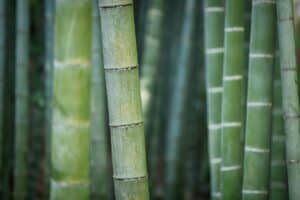The need for climate change solutions grows increasingly dire as extreme weather events continue wreaking havoc on nations and populations worldwide. Many societies have dipped below poverty levels, lacking access to essentials for survival, such as shelter, food, clothing, water and sanitation. In some regions, poor infrastructure has also hindered economic prosperity.
A shift toward eco-friendly resource consumption and green construction provides an opportunity to fight climate change and poverty. That sustainable resource is bamboo.
Sustainability means using a product without causing significant environmental harm or hindering regrowth. Bamboo — found in countries like India, Australia and parts of Asia — is one commodity that’s taken center stage in the green movement.
There are nearly 1,450 bamboo species globally with the potential to grow 60 centimeters or more daily. Of course, rapid growth is highly dependent on the region’s climate and soil health.
Nevertheless, bamboo remains the fastest-growing plant worldwide and an essential product to many communities. This is primarily due to having few soil disturbances during harvesting, which ensures nutrient density and less erosion for continual regeneration.
Since 1990, exploitation of the world’s forests has resulted in a loss of 178 million hectares of trees — approximately the size of Libya. The illegal timber industry — worth about $51 billion to $152 billion yearly — has also sped up the rate of deforestation, threatening local communities that rely on natural products for food, a thriving economy and medicines.
Planting trees and creating conditions for the Earth’s forests to replenish themselves is the surest way to limit rising global temperatures and protect populations and livelihoods. Bamboo can therefore replace the heavy utilization of timber and other forest resources for wide-ranging purposes.
Saving people and the planet with bamboo
The world is at a crossroads regarding climate change and poverty. It’s become clear that humans can no longer afford to turn away from the effects of their overconsumption of timber and industries’ greenhouse gas emissions.
Forests are crucial ecosystems for delivering ecological stability, conserving biodiversity and sequestering carbon dioxide. They also help support livelihoods and ensure people’s basic needs get met. Bamboo is proving itself to be a sufficient alternative to conventional forest products.

There are numerous ways in which bamboo can win the fight against climate change and poverty. Trees and plants are essential to oxygen production and carbon sequestration. For example, studies have shown bamboo can produce 27.38 million tons of oxygen yearly in India, mainly due to how quickly it grows.
Additionally, one hectare of bamboo forest may sequester 12 metric tons of carbon annually — equal to 26,000 pounds. The rate of sequestration can potentially slow global warming.
As temperatures rise and extreme weather events grow increasingly prevalent, more populations become vulnerable to devastating impacts. The best method of preventing climate-related destruction and despair is to lean into sustainable solutions that keep greenhouse gases low, temperatures stable, and intense weather at bay.
Bamboo grows in some of the most poverty-stricken regions of the world — areas that are also most vulnerable to climate change. For example, Malawi’s poverty rate was 68.5%, taking the sixth spot for Africa’s poorest nations. Malawi — which has lost a significant forested land area — hopes to restore 11 million acres by 2030 by growing bamboo, absorbing stagnant water conducive to spreading Malaria.
Bamboo is already crucial to people’s lives in other ways throughout the world. For instance, China uses the entire bamboo plant from medicinal purposes and cooking to building materials and accessories. Because bamboo is part of the grass family, it also makes for quality textile material, ensuring people have long-lasting clothes.
A versatile material
Impoverished communities are perhaps most susceptible to housing problems amid climate change. Tsunamis in the Indian Ocean have wiped out coastal communities in Asia. At the same time, people without adequate shelter are often left exposed to the elements, including extreme heat waves and torrential rain.
Research has indicated that climate, weather and a lack of shelter can carry physical and mental health implications. These effects can include the spread of vector-borne diseases, respiratory and cardiovascular problems, anxiety, and adverse outcomes from air pollution.
The current green construction trend has tapped into bamboo’s potential as a durable, sustainable building material. It’s even six times stronger than steel, while steel’s energy use is nearly 50 times greater than bamboo’s.
Sustainable construction with bamboo materials can enable impoverished communities to upgrade their infrastructure and build stronger, weather-resistant housing for protection — this can also happen with lower environmental impacts at a fraction of the cost.
Additionally, bamboo is ideal for other purposes, such as manufacturing natural, biodegradable utensils, kitchenware, packaging materials and boxes.
The current consumption of forest resources needs to align with a healthy environment, which is why using a natural resource like bamboo can ensure great benefits for people and the planet.
Did you like it? 4.5/5 (28)







